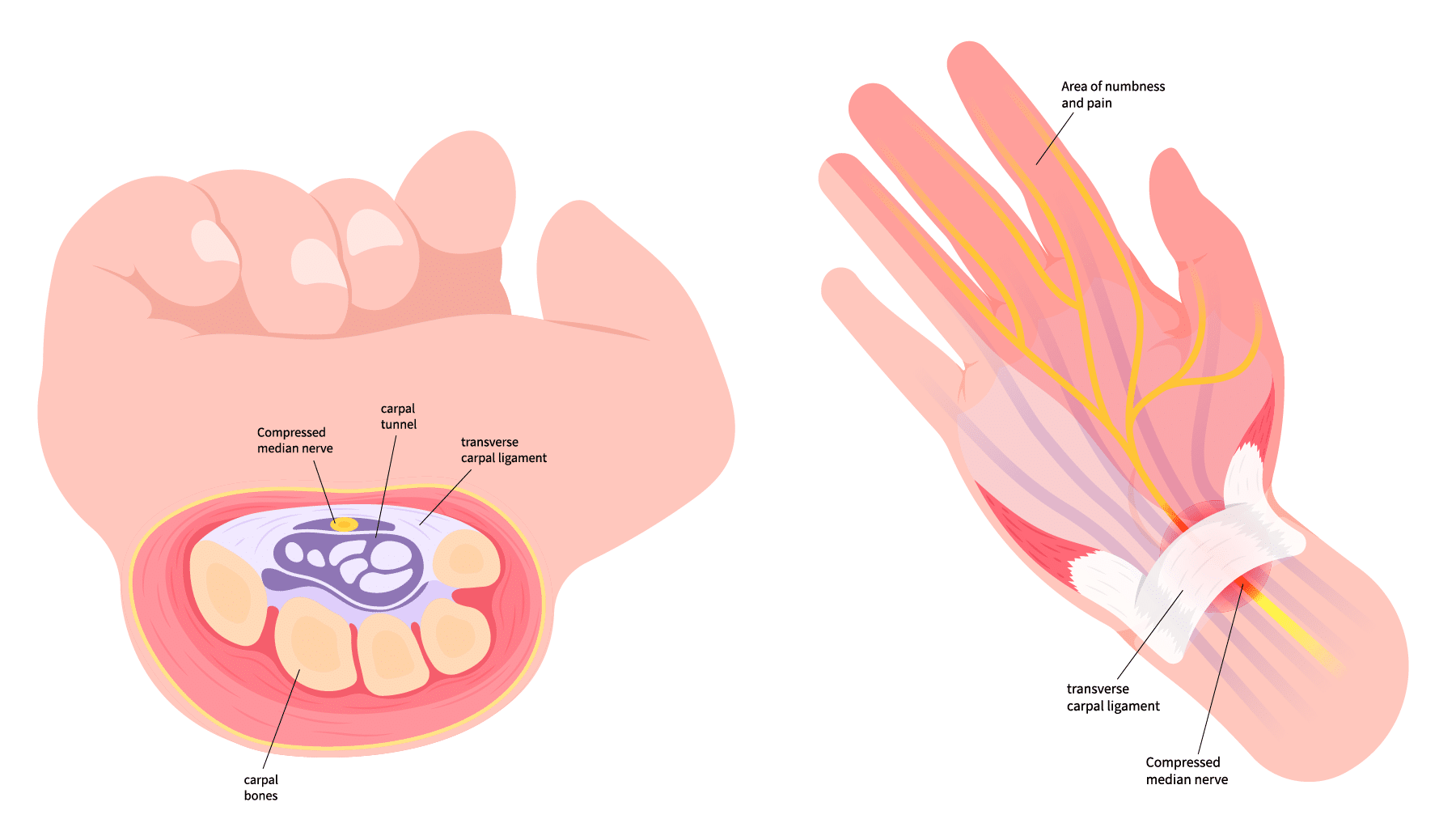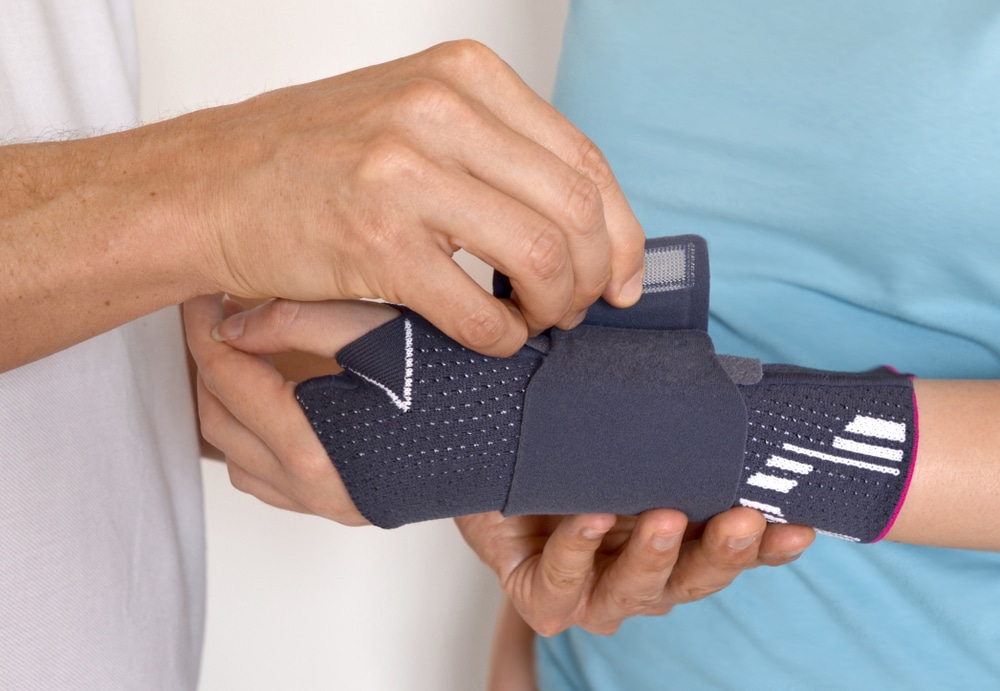Carpal tunnel syndrome (CTS) is a common wrist condition that occurs when the median nerve, which runs through the wrist, becomes compressed within a narrow passageway called the carpal tunnel.
This compression leads to pain, tingling, numbness, and weakness in the hand and fingers. It can significantly affect daily activities such as typing, gripping objects, or even sleeping comfortably.
CTS is one of the most frequently diagnosed peripheral nerve entrapment conditions and can impact individuals of all ages, although it is particularly common in adults between the ages of 40 and 60.
Anatomy and Physiology
The carpal tunnel is a rigid, narrow channel located on the palm side of the wrist. It is formed by the carpal bones at the base and the transverse carpal ligament across the top. Within this tunnel lie the median nerve and nine flexor tendons that control finger movement.
The median nerve is responsible for sensation in the thumb, index finger, middle finger, and part of the ring finger, as well as motor function (movement) for some of the small hand muscles.
Because the tunnel is rigid and confined, any swelling of the tendons, thickening of the ligament, or narrowing of the space can increase pressure on the median nerve. This pressure impairs normal nerve conduction, leading to the characteristic symptoms of carpal tunnel syndrome.

Causes and Risk Factors
Carpal tunnel syndrome develops when pressure within the carpal tunnel increases enough to compress the median nerve.
The causes are often multifactorial and may include:
- Repetitive hand or wrist movements, especially with forceful gripping or prolonged flexion and extension.
- Wrist injuries such as sprains, fractures, or dislocations that alter tunnel anatomy.
- Inflammatory conditions such as rheumatoid arthritis or tenosynovitis.
- Hormonal changes, including those that occur in pregnancy or menopause, which can cause fluid retention.
- Endocrine conditions such as diabetes or hypothyroidism that can predispose to nerve damage.
- Genetic predisposition due to naturally narrower carpal tunnels.
- People at higher risk include individuals with occupations or activities involving prolonged computer use, assembly line work, or use of vibrating hand tools.
- Women are more commonly affected than men, possibly due to smaller carpal tunnel dimensions.
Signs and Symptoms
The symptoms of carpal tunnel syndrome often start gradually and may worsen over time if not addressed.
Common features include:
- Numbness or tingling in the thumb, index, middle, and ring fingers, especially at night.
- Pain in the wrist or hand that may radiate up the forearm.
- Weakness in grip strength, leading to difficulty holding objects.
- A tendency to drop items unexpectedly.
- Burning or aching sensations in the hand.
- Worsening of symptoms during activities requiring wrist flexion or extension, such as typing, driving, or holding a phone.
Night-time symptoms are particularly common due to prolonged wrist flexion during sleep – we often curl up our hands and wrists during sleep.
Shaking the hands often provides temporary relief.
Assessment and Diagnosis
Clinical Assessment
Diagnosis begins with a detailed history and physical examination.
Key aspects of assessment include:
- Character and distribution of symptoms.
- Duration and progression of symptoms.
- Risk factors and occupational history.
On clinical examination, your specialist will assess:
- Sensation in the hand and wrist
- Muscle strength
- Signs of thenar (thumb) muscle wasting in severe cases.
- Range of movement
- They will also assess your neck and shoulder to help rule out other potential causes.
Special Tests
Specific clinical tests may be used to reproduce or confirm symptoms:
- Phalen’s Test: Flexing the wrists for 60 seconds to see if tingling develops.
- Tinel’s Sign: Tapping over the median nerve at the wrist to elicit tingling in the fingers.
- Durkan’s Test: Direct compression of the carpal tunnel to reproduce symptoms.
Imaging and Investigations
- Nerve Conduction Studies (NCS) and Electromyography (EMG) are the gold standard for confirming median nerve compression and assessing severity.
- Ultrasound may show swelling of the median nerve.
- MRI is occasionally used in atypical cases to rule out other causes of nerve compression.
Treatment Options

Conservative Management
Mild to moderate cases of carpal tunnel syndrome can often be managed without surgery. Strategies include:
- Wrist splinting, particularly at night, to maintain the wrist in a neutral position.
- Non-steroidal anti-inflammatory drugs (NSAIDs) for symptom relief.
- Corticosteroid injections into the carpal tunnel to reduce inflammation.
- Activity modification and ergonomic adjustments to reduce repetitive strain.
- Physiotherapy and exercises to improve nerve mobility and, hand, wrist and upper arm strength.
Surgical Management
Surgery is considered in cases where conservative measures fail, symptoms are severe, or there is evidence of muscle weakness or nerve damage. The most common operation is carpal tunnel release, which involves cutting the transverse carpal ligament to relieve pressure on the median nerve.
In almost all cases, this can be done as a day case using minimally invasive surgery
- Endoscopic Carpal Tunnel Release – A less invasive approach using a small camera and instruments through one or two tiny incisions.
Occasionally, with more complex cases, a slightly larger incision is required.
- Open Carpal Tunnel Release – A small incision is made in the palm to access the ligament.
Both procedures are highly effective, with success rates above 90% in most patients.
Prognosis and Recovery
With appropriate treatment, the prognosis for carpal tunnel syndrome is generally excellent. Many patients respond well to conservative measures, particularly if symptoms are addressed early. For those requiring surgery, recovery typically involves:
- Relief of night-time symptoms within days to weeks.
- Gradual return of strength and sensation over several months.
- Return to light activities within 2-3 weeks and full activities, including manual work, by 6-12 weeks.
Some patients with long-standing or severe nerve compression may experience persistent weakness or numbness even after surgery.
It’s important not to ignore symptoms and to seek diagnosis and treatment early to improve your prognosis and recovery.
When to Seek Help
You should seek specialist advice if you experience persistent numbness, tingling, or weakness in your hand, particularly if symptoms affect daily activities or disturb your sleep.
Early intervention can prevent progression and improve outcomes.
At London Bridge Orthopaedics, our specialists provide comprehensive assessment, diagnostic testing, and both non-surgical and surgical treatment options tailored to your needs.
Frequently Asked Questions
What are the first signs of carpal tunnel syndrome?
The earliest signs usually include tingling, numbness, or a “pins and needles” feeling in the thumb, index, and middle fingers, often worse at night. Some people also notice hand weakness or a tendency to drop objects.
Can carpal tunnel syndrome go away on its own?
Mild cases may improve with rest, activity modification, and splinting. However, without treatment, symptoms often progress over time. Early intervention helps prevent permanent nerve damage.
How do you test for carpal tunnel syndrome at home?
Simple tests like bending your wrists forward (Phalen’s test) or tapping the inside of your wrist (Tinel’s sign) can reproduce symptoms, but these are not always reliable. A specialist assessment with nerve conduction studies provides a clear diagnosis.
Is surgery the only cure for carpal tunnel syndrome?
No. Many patients respond well to conservative treatments such as splinting, injections, and physiotherapy. Surgery is usually only recommended if symptoms are severe, persistent, or causing muscle weakness.
How long does recovery take after carpal tunnel surgery?
Most patients notice relief from night-time numbness within a few days. Light activities can resume in 2–3 weeks, while full recovery, including return to heavy manual work, may take 6–12 weeks. Complete recovery of strength and sensation may take longer in chronic cases.
References
1. National Institute for Health and Care Excellence (NICE). (2018). Carpal Tunnel Syndrome. Available at: https://www.nice.org.uk/
2. Bland, J.D.P. (2007). Carpal tunnel syndrome. BMJ, 335(7615), 343–346.
3. Atroshi, I., et al. (1999). Prevalence of carpal tunnel syndrome in a general population. JAMA, 282(2), 153–158.
4. American Academy of Orthopaedic Surgeons (AAOS). (2023). Carpal Tunnel Syndrome. Available at: https://orthoinfo.aaos.org/






